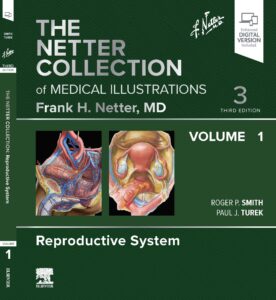As Good As I Get (At Science Writing)

What happens when you pour all your heart and soul into something? When cooking, this could mean a fabulous meal that is scrumptious, succulent, savory, heavenly, luscious, mouthwatering, toothsome and divine. When creating art, it may skillfully tug at emotions, provoke a mood, offer a fresh perspective, teem with creativity, or be ripe with otherworldly meaning. Likewise, good writing can pull you into its world and escape reality, provoke a meditative calmness, inform and change beliefs, powerfully connect, and compel and motivate behavior. As author of the latest edition of the newly released Netter’s Collection of Medical Illustrations, I have put all that I have (and am) into the Reproductive Volume. I have thrown my mind’s book at this book.
Netter Who?
Dr. Frank Netter was formally trained as an artist and surgeon in the early 20th century. In fact, art came first, as he gave up practicing medicine to dedicate his life to medical illustration. Over a 50-year period, he painted nearly 4,000 pieces, now housed in countless medical publications. To put this in perspective, he researched, sketched, and completely painted a medical image every three business days throughout his adult life. In 1948, he first codified and published the now legendary tome of images universally known in medicine as “The Green Book.” This absolute staple of medical education in America is the gift traditionally given to newly minted medical students by proud parents. So moved, the famed heart surgeon Dr. Debakey considered Dr. Netter’s contribution to the study of human anatomy “epochal” and stated that “he has advanced our understanding of anatomy more than any other medical illustrator since the 16th century, when Vesalius introduced drawings based on cadaveric dissections.” Yep, The Green Book rocks!
Why Me?
When I was asked to author the second edition (55 years later!) of The Green Book a dozen years back, I was humbled and flabbergasted. I wondered how I could possibly improve on this masterpiece, as the breadth and depth of his understanding of human biology was simply stunning to behold. Deeming it a bucket-list item in my career, I dove into it with heart and soul and challenged myself to be certain that what I wrote will be as true and as forward-looking as when Frank Netter first penned it a half century earlier.
A Lofty Redux
Now, tasked with responsibility of creating the 3rd and latest edition of Netter’s Collection of Medical Images, the endeavor was no less daunting. Luckily, with medical knowledge doubling every decade, there are many concepts worthy of introduction or updating. These include advances in our understanding of reproductive biology, assisted reproduction, and gender reassignment surgery, fields that have exploded in success and popularity since the last edition.
But I am still entirely intimidated and utterly inspired by the brilliance of my predecessor. My approach was to step into his shoes and to think as Netter thought. The Netter Collection seeks to be a transgenerational, timeless work. In the words of Virginia Woolf, “Masterpieces are not single and solitary births; they are the outcome of many years of thinking in common.” Likewise, truth and fact take years to decipher from the theoretical. It is my hope that by standing on the shoulders of giants, this masterpiece of medical art continues this august tradition.









